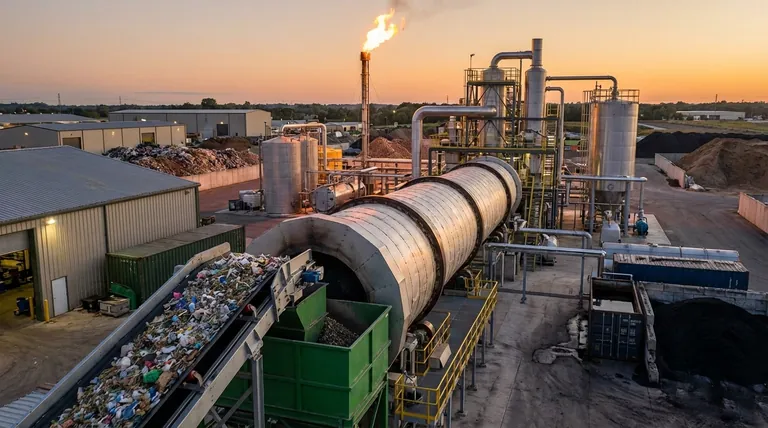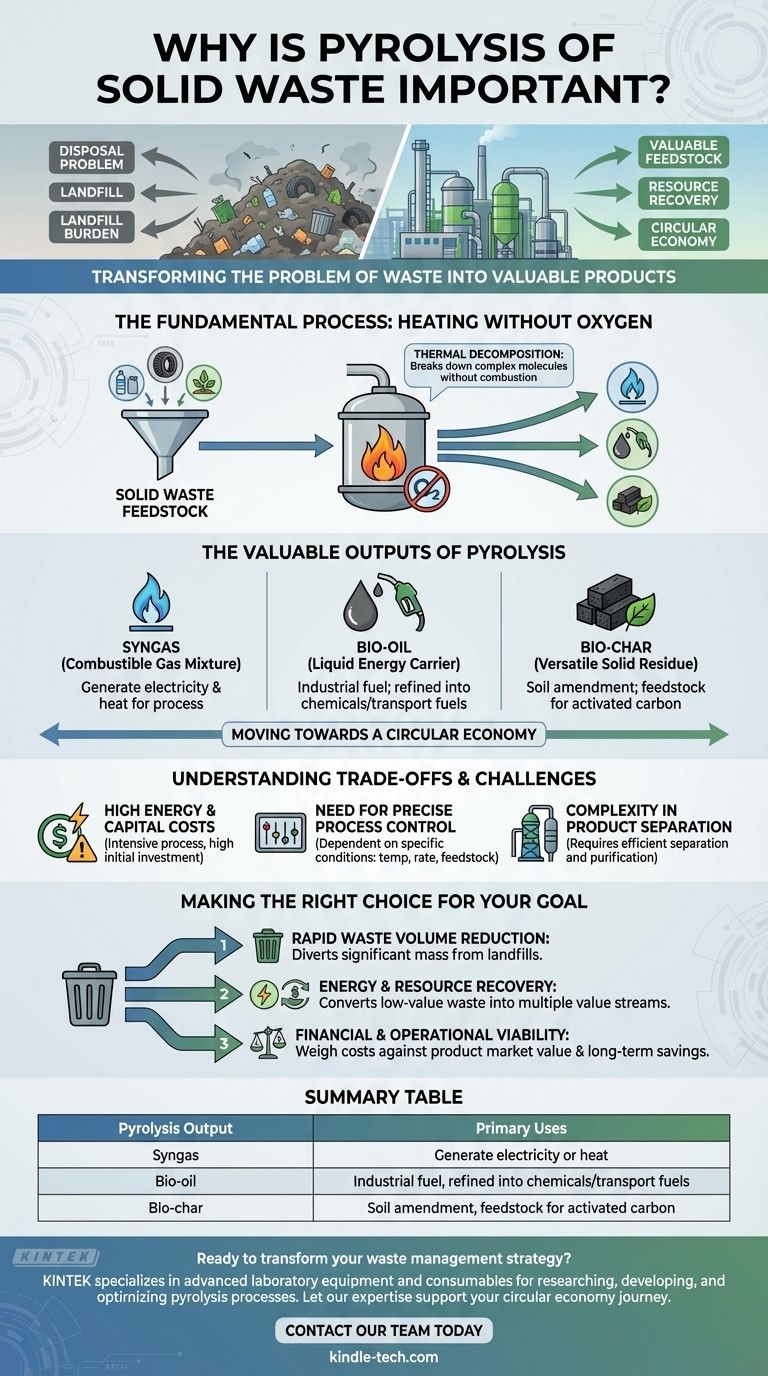At its core, pyrolysis is important because it transforms the fundamental problem of waste. It is a promising technology that converts solid waste materials—which would otherwise occupy landfills—into a portfolio of valuable products, including fuels and industrial materials, by heating them in an oxygen-free environment.
Pyrolysis represents a critical shift in perspective: instead of viewing solid waste as a disposal problem, it treats it as a valuable feedstock. This approach simultaneously reduces landfill burdens and recovers resources, moving us closer to a circular economy.

How Pyrolysis Redefines "Waste"
Pyrolysis is not incineration. By removing oxygen from the equation, it chemically decomposes organic materials rather than simply burning them. This distinction is the source of its unique benefits.
The Fundamental Process: Heating Without Oxygen
The process involves heating solid waste, such as plastics, tires, or biomass, to high temperatures in a reactor that is void of oxygen.
This thermal decomposition breaks down complex molecules into simpler, more useful components without combustion. The result is not smoke and ash, but a mix of a gas, a liquid, and a solid.
From Landfill Burden to Resource Feedstock
The primary importance of pyrolysis is its ability to drastically reduce the volume of waste destined for landfills.
This alleviates pressure on land use, decreases the environmental impact of waste disposal, and turns a costly liability into a source of potential revenue.
The Valuable Outputs of Pyrolysis
Unlike burning, which produces mostly heat and ash, pyrolysis creates three distinct and usable product streams. The specific yield and quality depend on the feedstock and process conditions.
Syngas: A Combustible Gaseous Fuel
One of the outputs is syngas (synthesis gas), a mixture of combustible gases. This gas can be burned to generate electricity or heat, often to power the pyrolysis facility itself, making the process more self-sustaining.
Bio-oil: A Liquid Energy Carrier
Pyrolysis also produces a liquid known as bio-oil or pyrolysis oil. This dense liquid can be used as an industrial fuel or further refined into higher-grade transportation fuels and chemicals.
Bio-char: A Versatile Solid Residue
The solid product is bio-char, a stable, carbon-rich material. It can be used as a fuel, but its greater value often lies in its use as a soil amendment to improve fertility or as a feedstock for producing high-grade activated carbon.
Understanding the Trade-offs and Challenges
While promising, pyrolysis is not a perfect solution. Acknowledging its challenges is crucial for a realistic assessment of its viability.
High Energy and Capital Costs
Pyrolysis is an energy-intensive process that requires significant heat. Furthermore, building a pyrolysis facility involves high initial capital costs, which can be a barrier to adoption.
The Need for Precise Process Control
The efficiency of the process and the quality of the end products depend heavily on specific conditions like temperature, heating rate, and feedstock composition. Maintaining these conditions requires sophisticated control systems.
Complexity in Product Separation
The resulting syngas, bio-oil, and bio-char must be efficiently separated and often purified before they can be used. This adds another layer of technical complexity and cost to the overall operation.
Making the Right Choice for Your Goal
Adopting pyrolysis requires aligning the technology's capabilities with specific strategic objectives.
- If your primary focus is rapid waste volume reduction: Pyrolysis is a highly effective method for diverting a significant mass of waste from landfills.
- If your primary focus is energy and resource recovery: The technology excels at converting low-value waste into multiple value streams, including gas, liquid fuel, and solid carbon products.
- If your primary focus is financial and operational viability: You must carefully weigh the high capital and energy costs against the market value of the recovered products and the long-term savings from avoided landfill fees.
Ultimately, pyrolysis offers a powerful tool for transforming waste management from a linear path of disposal to a circular system of resource recovery.
Summary Table:
| Pyrolysis Output | Description | Primary Uses |
|---|---|---|
| Syngas | Combustible gas mixture | Generate electricity or heat for the process |
| Bio-oil | Liquid energy carrier | Industrial fuel; refined into chemicals/transport fuels |
| Bio-char | Carbon-rich solid residue | Soil amendment; feedstock for activated carbon |
Ready to transform your waste management strategy? Pyrolysis technology can turn your solid waste liabilities into valuable resources like fuel and industrial materials. At KINTEK, we specialize in advanced laboratory equipment and consumables to help you research, develop, and optimize pyrolysis processes. Let our expertise support your journey toward a circular economy—contact our team today to discuss your specific laboratory needs and goals.
Visual Guide

Related Products
- Electric Rotary Kiln Small Rotary Furnace Biomass Pyrolysis Plant
- Electric Rotary Kiln Continuous Working Small Rotary Furnace Heating Pyrolysis Plant
- Laboratory Quartz Tube Furnace Tubular RTP Heating Furnace
- Customizable High Pressure Reactors for Advanced Scientific and Industrial Applications
- High Pressure Laboratory Autoclave Reactor for Hydrothermal Synthesis
People Also Ask
- What are the products of pyrolysis of biomass? Unlock Bio-Char, Bio-Oil, and Syngas
- What are the conditions for biomass pyrolysis? Optimize Temperature, Heating Rate & Time
- What are the advantages of pyrolysis technology? Turn Waste into Profit and Reduce Emissions
- What is the process of biomass fast pyrolysis? Turn Biomass into Bio-Oil in Seconds
- What are the reactions involved in pyrolysis of biomass? Unlock the Chemistry for Tailored Bio-Products



















